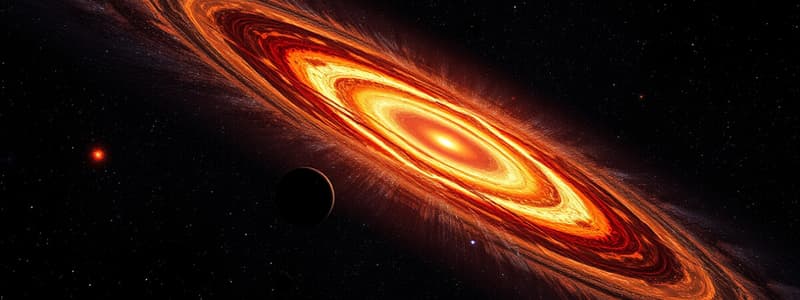Podcast
Questions and Answers
What is the Nebular Theory?
What is the Nebular Theory?
The Nebular Theory states that the solar system originated from a nebula, which is a giant cloud of gas and dust in space.
What elements are primarily found in a nebula?
What elements are primarily found in a nebula?
- Oxygen
- Carbon
- Helium (correct)
- Hydrogen (correct)
What are the three major steps in the formation of the solar system?
What are the three major steps in the formation of the solar system?
- Cloud collapse, 2. Formation of protoplanetary disk, 3. Growth of planets.
What causes a cloud collapse in the nebular theory?
What causes a cloud collapse in the nebular theory?
Why could terrestrial planets form near the sun?
Why could terrestrial planets form near the sun?
In step 3 of the solar system formation, dust and grains surrounding the sun formed into __________.
In step 3 of the solar system formation, dust and grains surrounding the sun formed into __________.
The Nebular Theory states that Saturn's particles attract each other.
The Nebular Theory states that Saturn's particles attract each other.
What is the Encounter Theory?
What is the Encounter Theory?
What does the Planetesimal Theory propose?
What does the Planetesimal Theory propose?
Who was a proponent of the Planetesimal Theory?
Who was a proponent of the Planetesimal Theory?
What does the Tidal Theory explain?
What does the Tidal Theory explain?
Flashcards are hidden until you start studying
Study Notes
Nebular Theory
- Solar system formation began from a nebula approximately 4.5 billion years ago.
- A nebula is a vast cloud of gas and dust primarily composed of hydrogen, helium, and other ionized gases.
Major Steps in Solar System Formation
- Formation occurs in three main stages:
- Cloud collapse
- Formation of a protoplanetary disk
- Growth of planets
Step 1: Cloud Collapse
- Shockwaves from supernova events or nearby stars can trigger cloud collapse.
- Gravity causes the center of the gas and dust cloud to collapse, resulting in faster rotation.
Step 2: Formation of Protoplanetary Disk
- Metals and silicates near the young sun lead to the creation of terrestrial planets (Mercury, Venus, Earth, Mars).
- Limited metallic reserves in the solar nebula restrict the size growth of these planets.
Step 3: Growth of Planets
- Dust and grains surrounding the sun coalesce into clumps, forming planetesimals.
- Planetesimals are small bodies that collide and fuse to create planets.
Proponents of the Nebular Theory
- Key figures include Emmanuel Swedenborg, Immanuel Kant, and Pierre-Simon Laplace, recognized for their contributions to the theory.
Drawbacks of the Nebular Theory
- Observations of particles around Saturn show repulsion, challenging the idea that dust particles easily form planets.
- The model does not comply with angular momentum laws, suggesting the sun should spin faster than other celestial bodies.
Encounter Theory
- Proposes planets formed from materials ejected from the sun after a close encounter with another celestial object like a star.
- Involves two variations: planetesimal theory and tidal theory.
Planetesimal Theory
- Introduced by Thomas Chrowder Chamberlin, suggesting a near-collision with an intruding star caused the protosun to eject materials that condensed into planetesimals.
- Forest Ray Moulton provided mathematical support for Chamberlin's concepts.
Tidal Theory
- Suggests solar system formation resulted from a close encounter between a passing star and the sun.
- Proposes that hot gas from the star condensed into planets rather than merging into other formations.
Studying That Suits You
Use AI to generate personalized quizzes and flashcards to suit your learning preferences.





